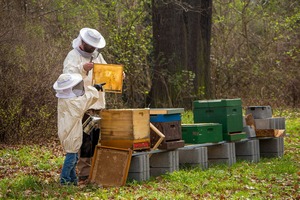Bees and Man

Many years ago, back in the history of man, people discovered that bees stored honey and that the honey was good to eat. At first, they destroyed the nest to get the honey. Later they found out how to take away just the extra honey so that the bees could go on raising brood and producing more honey. People also found that beeswax was useful for many things, especially for making candles to light their homes. At one time beeswax was so valuable that it was used as money.
Bees were so useful to man that he began to keep them in hives where he could raise them and try to control their activities. Today beekeepers use a hive like the one in the picture, where the bees build their comb on frames which can be removed without hurting the bees or comb. There is not as much need for beeswax now so beekeepers raise bees to produce honey and also for pollinating farmers' crops. Plants are pollinated when pollen from the male ï¬ower part is moved to the female ï¬ower part. Some people have even experimented by giving bees man-made plastic comb, so that the bees can spend less time and energy making comb and more time food collecting and honey making. However, the bees seem to prefer their own wax comb even though they will use plastic honeycomb when it is provided.
Man, not only can keep colonies of bees where he wants them but he can also create as many colonies as he needs. In the past, the beekeeper had to wait for the spring season to catch bee swarms to place in a new hive to get a new colony. Today new colonies are started by simply dividing a colony in half and placing a queen in the colony that needs one. He gets the queen from a special queen-producing colony (see Raising a New Queen for an explanation). In addition, beekeepers today can produce the kinds of bees they need for a particular job. (see The Life of a Drone for an explanation) Beekeeping is so important to us that it has become an important industry. There are thousands of bee-keepers today. Some keep bees to produce honey and some rent hives to farmers who grow plants that need pollinating. Others produce tons of living bees, and hundreds of thousands of queens that are sold to beekeepers who start new colonies.
There are many different ï¬avors and colors of honey, depending on the plant from which the bees collected the nectar. For example, clover, sage, and orange honey are well-known types. Modern beekeepers try to keep the hives in areas where plants are producing large quantities of nectar of a particular type. To do this they may move the hives 4 to 6 times each year to different areas where a particular plant is ï¬owering in great numbers. Large trucks are used to move hundreds of hives in one load. To keep the types of honey separated, the beekeeper must harvest each type as soon as the particular kind of plant has ï¬nished blooming. Otherwise different kinds of honey become mixed. Often mixing is desirable to produce new, even more delicious ï¬avors. Under ideal conditions a colony may produce as much as ï¬ve pounds of honey each day. Yet, at other times, when there is not very much nectar, the beekeeper must feed sugar syrup the colonies. A single hive may produce 100 pounds of honey or more in a year. The most important us for bees today is not honey production, but ï¬ower pollination.
The Bees section was created with special thanks to Louis Juers (Arizona State Parks & Trails) for providing information used in this section. Additional information and digital materials were obtained from some of the following organizations. We would like to thank them for all their dedication and hard work within their profession.
|









